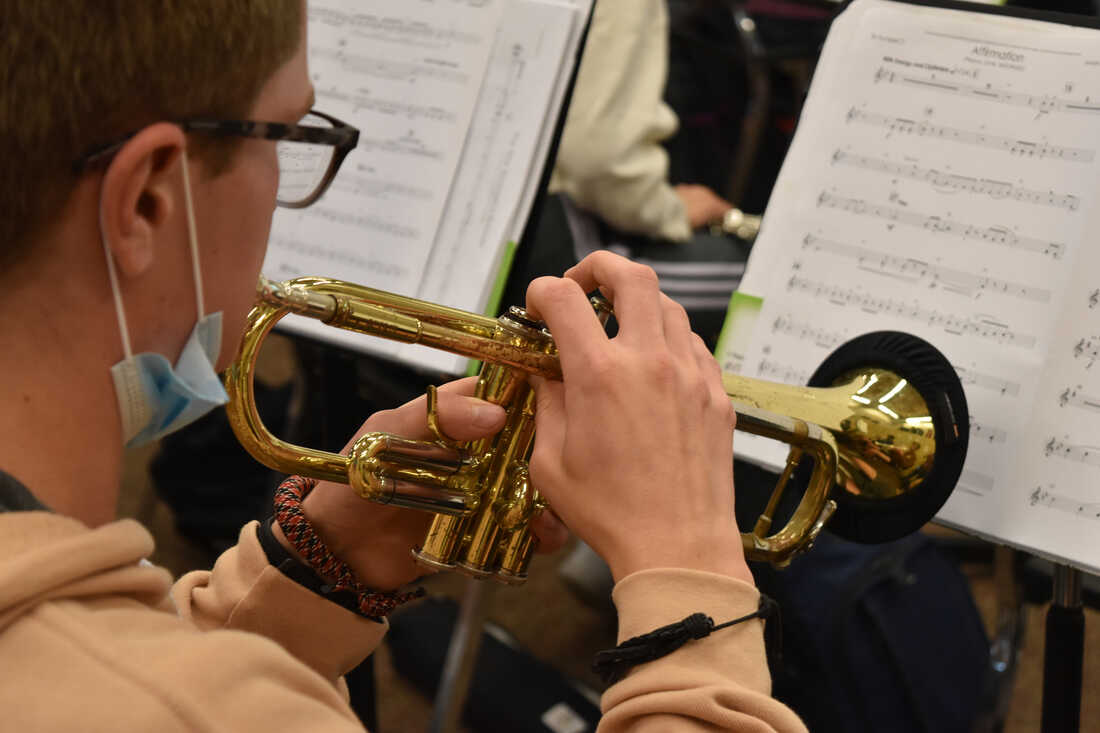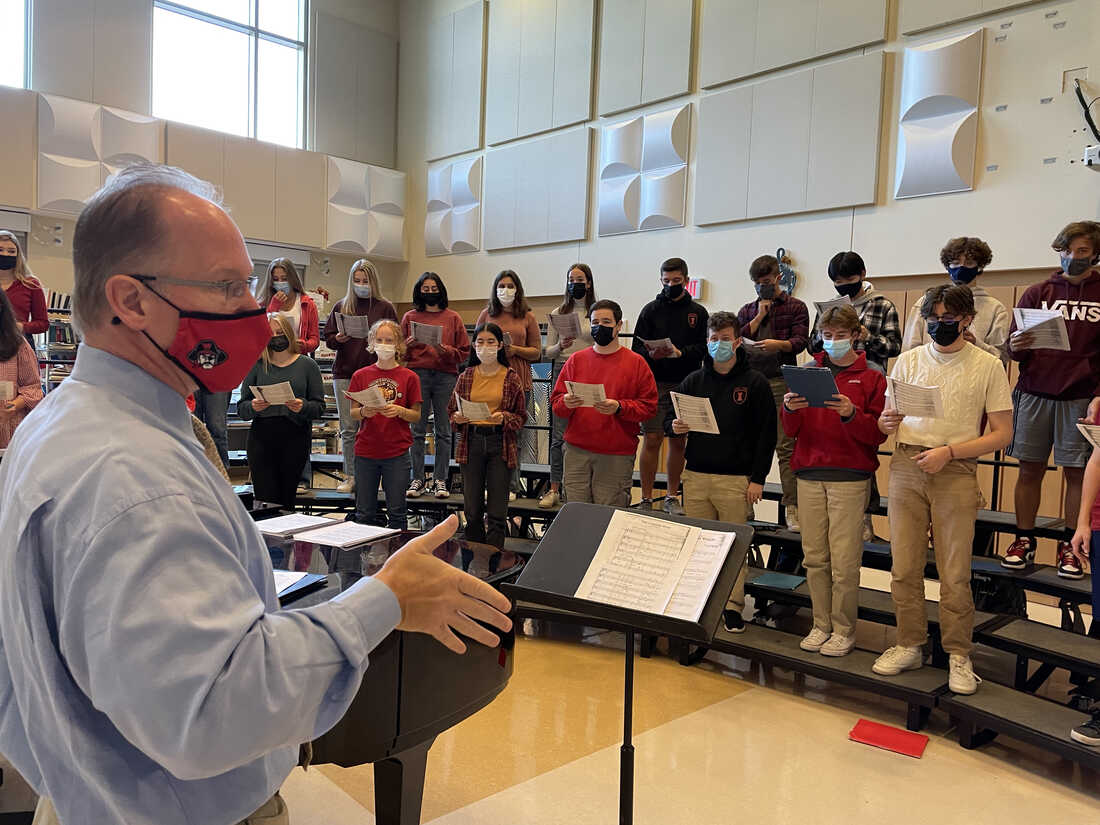
[ad_1]

Wellesley high schooler Andrew Song plays baritone sax in the jazz band.
Craig LeMoult/GBH
hide caption
toggle caption
Craig LeMoult/GBH

Wellesley high schooler Andrew Song plays baritone sax in the jazz band.
Craig LeMoult/GBH
Last year, band and choir classes were a far cry from normal, with students practicing outside or over Zoom. But with students back in school this fall, many are overjoyed to take part in almost-normal music classes. That includes senior tenor sax player Frank Papetti.
“Oh my God, I’m super excited,” he says. “I love playing my instrument,” Papetti is a member of the wind ensemble at Westwood High School, about 24 miles south of Boston.
He says last year was tough. The school’s hybrid schedule meant that about half the time, he attended class remotely. In music classes, students had to mute their microphones and play along at home.
“Yeah, you kind of feel isolated,” says Papetti. “It kind of turns you off in a sense. You don’t really want to play. No one can hear you.”
His teacher, Heather Cote, who directs the Westwood High School wind ensemble, says the group was able to practice outside last year, but it got harder as the weather cooled off. And the hybrid schedule wasn’t great for a music class. Her students were split into two cohorts that came to school in-person on different days.
“You didn’t have the whole group together, so sometimes the balance was weird and you had too many of one instrument because all the other ones were in the other cohort,” Cote says.

Heather Cote, K-12 Director of Performing Arts at Westwood Public Schools, directs the high school wind ensemble.
Craig LeMoult/GBH
hide caption
toggle caption
Craig LeMoult/GBH

Heather Cote, K-12 Director of Performing Arts at Westwood Public Schools, directs the high school wind ensemble.
Craig LeMoult/GBH
“The first day that we were in here this fall and they all played together, I started to tear up,” says Cote.
Things do look a little different in wind ensemble this year: There are black filters covering most instruments’ bells — the end where the sounds, and aerosols, come out of a wind instrument.
“Honestly, it doesn’t make that much of a difference,” Papetti says. “It doesn’t make your sound much different at all.”
This return to in-person, indoor playing has been guided by best practices developed specifically for performers.
More than a hundred performing arts organizations around the country raised funds for a groundbreaking study after a choir in Washington state became one of the first known COVID-19 superspreader events in the country.
“When we looked at that incident, we’re like, ‘Yep, this is going to be detrimental to all things performing arts if we don’t figure out how to do this,” says Dr. James Weaver of the National Federation of State High School Associations.
Weaver and Dr. Mark Spede of the College Band Directors National Association teamed up to support research looking at how to prevent the spread of the virus in performing arts settings, delving into the problem as early as April and May 2020.

Westwood High School trumpet player James Beggan.
Craig LeMoult/GBH
hide caption
toggle caption
Craig LeMoult/GBH

Westwood High School trumpet player James Beggan.
Craig LeMoult/GBH
The study, conducted by scientists at the University of Colorado Boulder and the University of Maryland, involved asking performers to sing or play alone in a room. Researchers used lasers and high-speed cameras to visualize how aerosols spread from instruments and singers, with and without filters.
“When you put on the mask or bell cover, the area that is immediately directly affected by a breath shrinks by one-third, which is enormous,” says Dr. Jelena Srebric of the University of Maryland.
The study’s authors put out a list of recommendations for performing arts groups that include the use of bell covers for bands and masks for choruses when they rehearse indoors. They also suggest physical distancing, added air filtration and playing outdoors whenever possible.
Weaver says roughly 20 states are requiring these steps and 20 more have some sort of recommendation to follow the guidelines.
The high school jazz ensemble in Wellesley, Mass. is going a step further. As junior Max Goldenson points out, even as he plays his trumpet, he’s wearing a mask.
“There’s a hole in the center and each side has a magnet on it, so you can kind of clip it closed whenever you’re not playing,” he says.

Wellesley High School choral director Kevin McDonald instructs the school’s Keynote Singers.
Craig LeMoult/GBH
hide caption
toggle caption
Craig LeMoult/GBH

Wellesley High School choral director Kevin McDonald instructs the school’s Keynote Singers.
Craig LeMoult/GBH
Down the hall, about 40 masked members of Wellesley High’s “Keynote Singers” are back together, too, rehearsing a James Taylor song called That Lonesome Road.
“For all of us, this is our community. This is where we find joy in our day to day. It’s a break from the schoolwork,” says senior Nora Jarquin. “All my friends are in these choirs and in these groups. So to lose that was a really hard time. We don’t want to do that again.”
They’re all hoping, with these new protective measures, that they won’t have to.
[ad_2]
Source link
